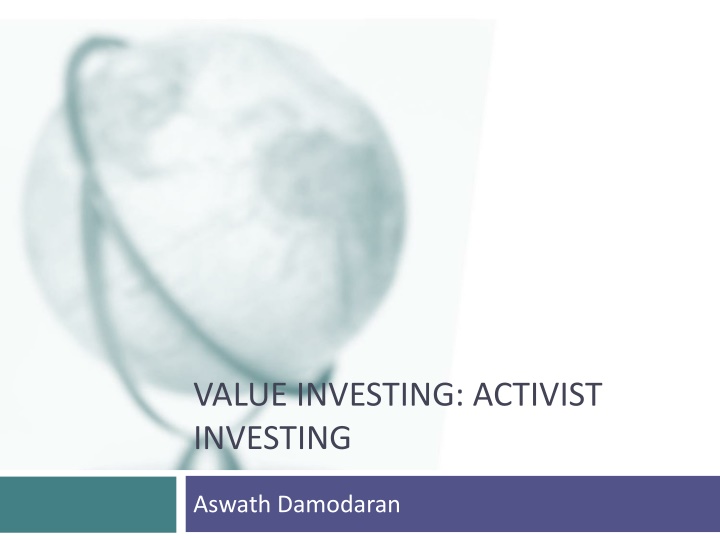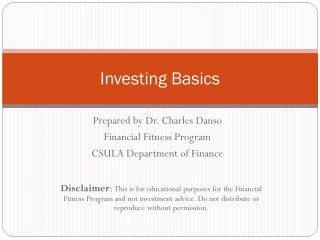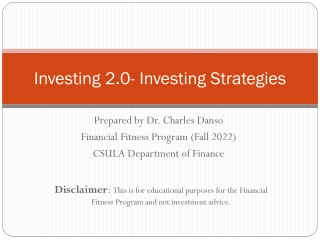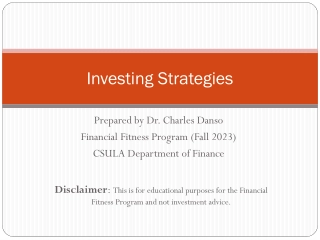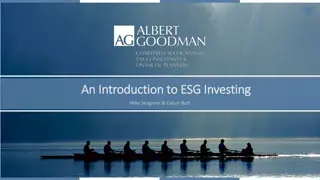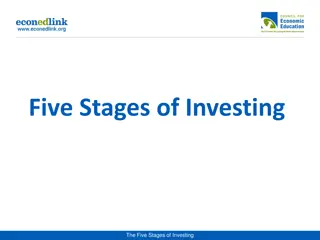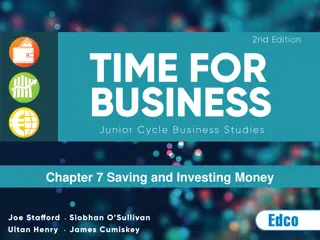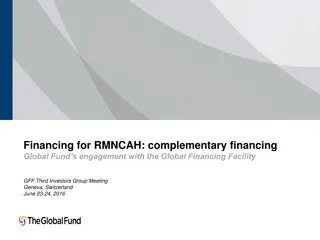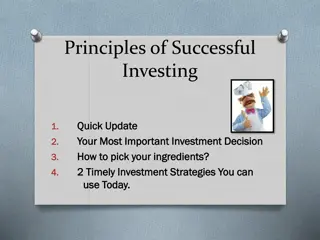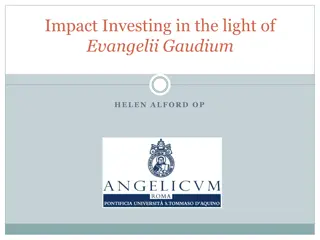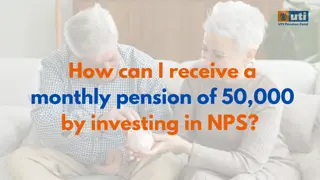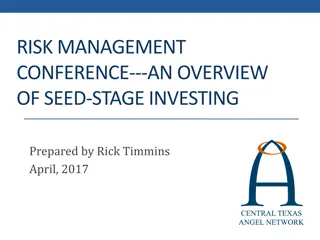Activist Investing Insights: Strategies and Impact
Unveil the nuances of activist investing, its classes, tactics, and outcomes like challenging management, driving change, and enhancing governance in target companies. Discover how activist investors strive to close value gaps, influence management structure, and elevate performance.
Download Presentation

Please find below an Image/Link to download the presentation.
The content on the website is provided AS IS for your information and personal use only. It may not be sold, licensed, or shared on other websites without obtaining consent from the author.If you encounter any issues during the download, it is possible that the publisher has removed the file from their server.
You are allowed to download the files provided on this website for personal or commercial use, subject to the condition that they are used lawfully. All files are the property of their respective owners.
The content on the website is provided AS IS for your information and personal use only. It may not be sold, licensed, or shared on other websites without obtaining consent from the author.
E N D
Presentation Transcript
VALUE INVESTING: ACTIVIST INVESTING Aswath Damodaran
Classes of Activist Investors Lone wolves: These are individual investors, with substantial resources and a willingness to challenge incumbent managers. Institutional investors: While most institutional investors prefer to vote with their feet (selling stock in companies that are poorly managed), a few have been willing to challenge managers at these companies and push for change. Activist hedge & private equity funds: . A subset of private equity funds have made their reputations (and wealth) at least in part by investing in (and sometimes buying outright) publicly traded companies that they feel are managed less than optimally, changing the way they managed and cashing out in the market place. A key difference between these funds and the other two classes of activist investors is that rather than challenge incumbent managers as incompetent, they often team up with them in taking public companies into the private domain, at least temporarily. 2
Activist Value Investing Activist investors buy companies with a value and/or pricing gap and provide the catalysts for closing the gaps. Passive investors buy companies with a pricing gap and hope (and pray) that the pricing gap closes. 3
The typical target company in a PE buyout is one that is under performing its peer group in profitability and stock price performance, and with relatively small insider holdings. Who do they target? 4
You have to be able to buy the target company at the right price. And what are their reasons? 5
On the governance part they push for changes Board of directors: The board of directors at target firms is picked by the equity investors in the buyout deal and therefore is more active in overseeing management. Boards of the targeted firms tend to become smaller and meet more frequently after buyouts. More of the directors are picked for their expertise in the target firm s business Top management: While some of the managers in the target firm are part of the buyout team, there is also a greater push on accountability and compensation: The likelihood of CEO turnover jumps at firms that have been, increasing 5.5% after the targeting. One study found that two-thirds of CEO of buyout companies were replaced within four years of buyout. CEO compensation decreases in the targeted firms in the years after the activism, with pay tied more closely to performance. 7
On the operating end less in invested back into existing businesses The firms that are targeted by PE investors tend to be investing less in their businesses than their peer group even before the PE and there is a decline in that reinvestment after the PE. Cap ex as % of total assets 9.00% 8.00% 7.00% 6.00% 5.00% 4.00% 3.00% 2.00% 1.00% 0.00% Control firms Target firms, pre-PE Target firms, post When growth firms are targeted by PE groups, there is no perceptible decrease in R&D and other investments after the buyout. PE 8
And there is asset redeployment There is an increase in divestitures, especially in non- core businesses, for firms with business sprawl. There is very little evidence of wanton stripping of assets for cash, i.e., the divestitures are generally not overboard are driven by the need to service debt. At the same time, many targeted firms find new businesses to invest in and change their asset mix. 9
With effects on profitability Profit and PE: Changes in EBITDA/Sales at PE firms - Two years prior & after buyout 4.00% 3.00% 2.00% Change in EBITDA/Sales ratio Year: -2 1.00% Year: -1 Year +1 0.00% All PE firms In highly levered PE In lightly levered PE Year +2 -1.00% -2.00% -3.00% PE & Classified by leverage Target firms come into buyouts with declining profitability in the two years prior but see improvements in the two years after, and more so in highly levered firms. 10
On the financial front they do borrow money to finance the deal.. Debt as % of Transaction Value: Buyouts from 2000-2011 Debt as multiple of EBITDA at Buyout Companies 80% 7 70% Debt as multiple of EBITDA 6 60% 5 50% 4 40% Subordinated debt 3 30% Senior debt 2 20% 1 10% 0 0% 2000 2001 2002 2003 2004 2005 2006 2007 2008 2009 2010 2011 2000 2001 2002 2003 2004 2005 2006 2007 2008 2009 2010 2011 PE investors use more debt in funding transactions than other public companies. Default risk increase as debt increases as % of value and cash flows Existing bondholders/lenders may be adversely affected, if they did not protect themselves. 11
But PE record on default is only slightly worse than it is for non-PE firms with similar leverage Default rates: PE versus non-PE firms PE firms are less likely to be liquidated (11% vs 16%) & stay in bankruptcy for shorter periods than non-PE firms. 20.00% 18.00% 16.00% % of firms that defaulted during year 14.00% 12.00% 10.00% Non-PE firms 8.00% PE firms 6.00% 4.00% 2.00% 0.00% One study found that only 1.2% of PE firms defaulted between 1980 & 2002. In contrast, the default rate across all publicly traded firms was 1.6%. 12
And on dividend policy, they do take cash out of firms, but generally don t strip firms down.. Special dividends: While there are some who fear that PE investors pay themselves large dividends right after they take over target firms, special dividends remain rare. A study of 788 private equity targets, tracked from 1993 to 2009 found only 42 instances of special dividends paid to PE investors. Asset strips: While there are undoubtedly some PE houses that turn target companies into ATMs, selling assets and drawing cash out of them, they are not the norm. 13
Do activists make money? When the transaction is announced 14
Ways for PE to generate profits from the transaction Management fees: When the PE investor runs the company as a private business, the company will pay management fees for the services rendered by the PE investor. Make equity stake more valuable before exit: By finding market mistakes, making operating fixed or through financial engineering, try to reap the difference in value at exit (by taking company back public or by selling in a private transaction). 15
The returns to PE investors On average, PE investors deliver about 3% more each year than equivalent public investments. 17
But excess returns vary widely across PE investors.. 18
And even the best PE investors lose sometimes... But make up with big winners 19
Determinants of Success at Activist Investing Have lots of capital: Since this strategy requires that you be able to put pressure on incumbent management, you have to be able to take significant stakes in the companies. Know your company well: Since this strategy is going to lead a smaller portfolio, you need to know much more about your companies than you would need to in a screening model. Understand corporate finance: You have to know enough corporate finance to understand not only that the company is doing badly (which will be reflected in the stock price) but what it is doing badly. Be persistent: Incumbent managers are unlikely to roll over and play dead just because you say so. They will fight (and fight dirty) to win. You have to be prepared to counter. Do your homework: You have to form coalitions with other investors and to organize to create the change you are pushing for. 1. 2. 3. 4. 5. 20
